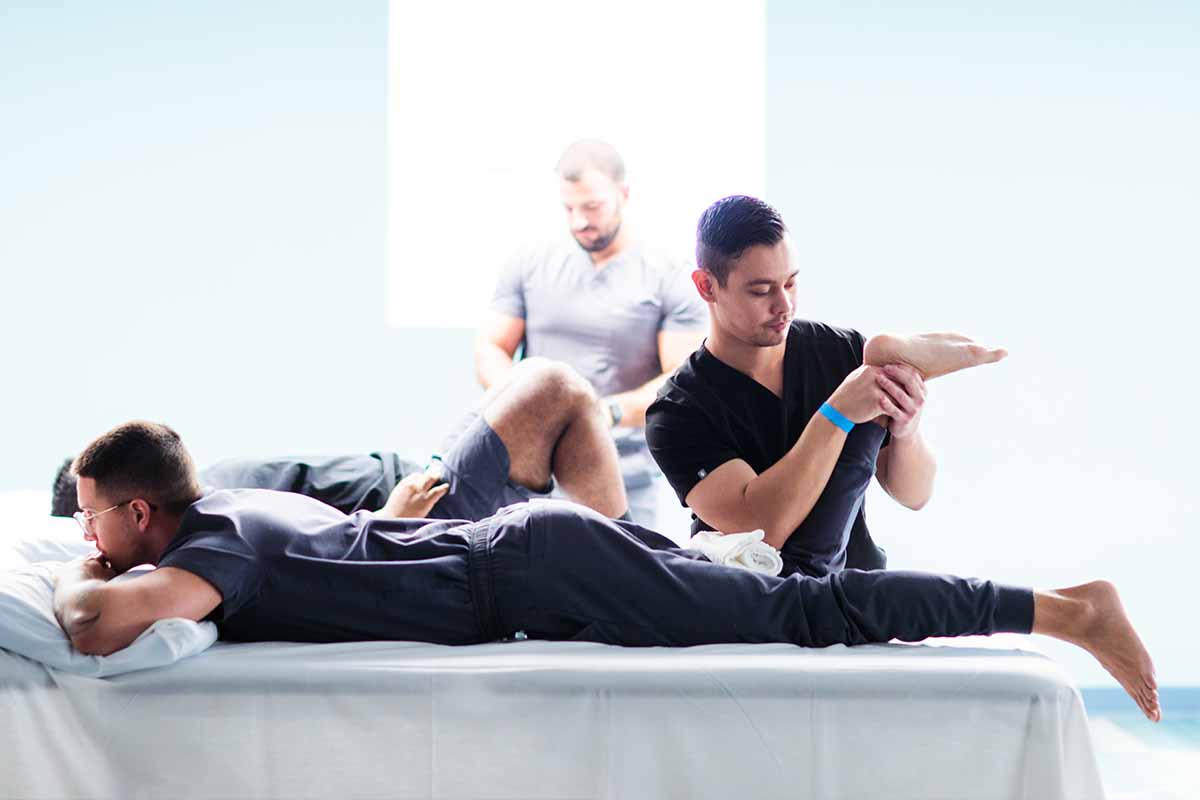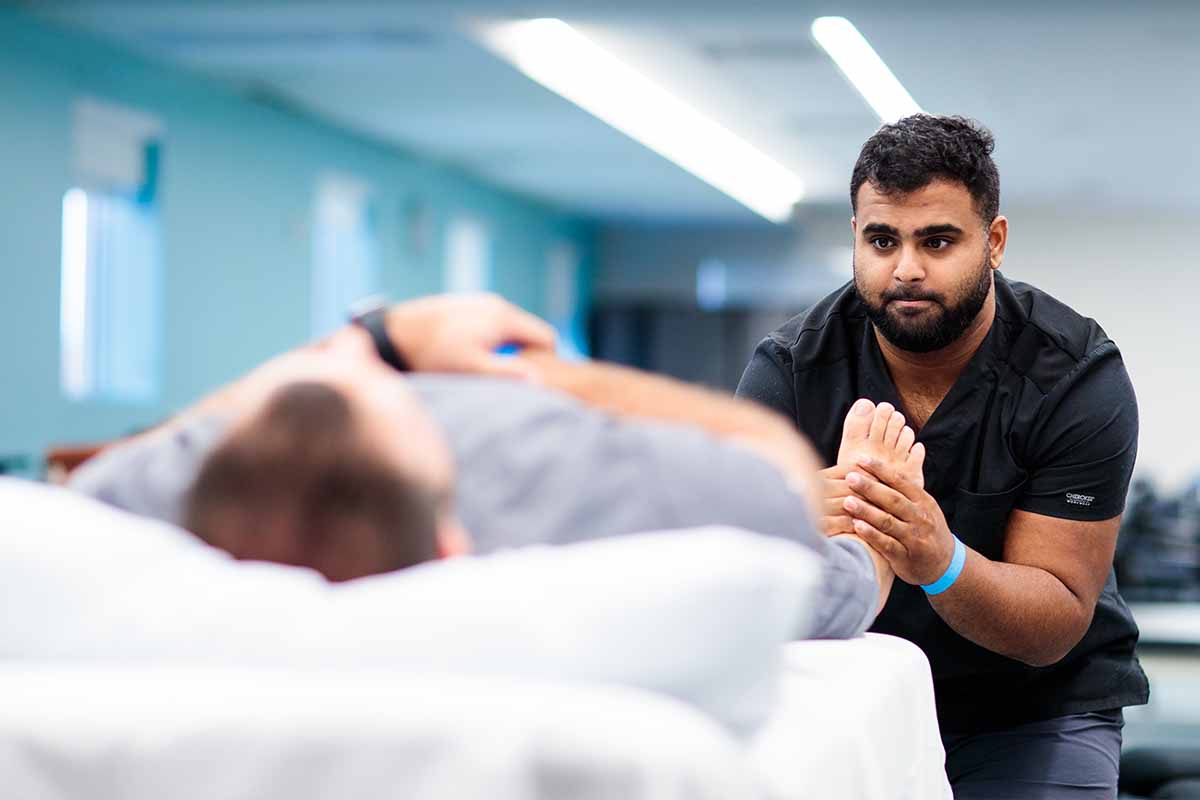
Applying to Master of Science in Speech-Language Pathology (MS-SLP) programs is an exciting next step after completing your undergraduate degree. However, it can be an overwhelming process with so many program options to choose from.
We’ve created this guide to help you navigate the application process. Learn how to choose an SLP program based on your unique requirements, and how to apply to an SLP program.
1. Location
Program location can be a determining factor in which programs you want to consider. Most programs are either fully in person or hybrid, so it’s important to determine if you’ll be able to meet in-person requirements.
The University of St. Augustine for Health Sciences (USAHS) offers a blended MS-SLP program with online coursework and four in-person residency experiences. This SLP program offers the best of both worlds, so you can enjoy the flexibility of online learning while interacting face-to-face with peers and professors.
If you’re financially able to relocate, it will open a lot more doors to find your ideal program.
If you want to get your license in a specific state, you should consider attending school there. However, you can always obtain a license in a different state after completing your program and meeting that state’s licensure requirements.
2. Cost
The cost of enrollment in an SLP master’s program will vary depending on the university.
Tuition, program fees, books and other school expenses are included in total program expenses.
- For the MS-SLP program at USAHS, tuition is approximately $13,580 per trimester for full-time students.
- USAHS students can apply for financial aid by contacting Admissions & Aid.
Loan, financial aid and scholarship availability will also vary by program and your financial situation. Scholarships and financial aid will also impact the amount of debt you have after completing your master’s degree. USAHS offers scholarships up to $13,000 that are paid in trimester-based increments. If you’re interested, we highly recommend reviewing the eligibility requirements and applying.
3. Program Size
You may choose your desired university and program size. A smaller program may provide more one-on-one opportunities with professors and clinicians, while a larger program may pave the way for additional resources and outside research opportunities.
Keep in mind the master’s program size will be much smaller than the size of your undergraduate cohort.
4. Full Time vs. Part Time
It’s important to determine how much time you’ll need to complete your master’s. If you need to work full time while completing your degree, you’ll likely need a program that allows you to attend school part time for a longer period of time.
However, you may be financially able to attend your program full time. In this case, you’ll complete your degree and advance in your career more quickly.
5. Online vs. In Person
You’ll find MS-SLP programs that offer both in-person and online programs. If for some reason you aren’t able to commit to a fully in-person program, you may opt for a hybrid program. USAHS offers a hybrid experience, through four in-person residency experiences, three trimesters of virtual clinical practica, and two trimesters of on-site clinical practica.
However, if you’re more of a hands-on student and would like to attend classroom lectures or you value the social aspect of school, then an in-person program may be the best option.
6. Specialization
A few SLP programs offer concentrations. If you choose to add a specialization to your master’s degree, there will be additional work involved.
Specializations include:
- Bilingual speech pathology
- Child language
- Non-verbal communication
- Voice disorders
- Dysphagia
Even if you don’t choose a concentration, you’ll be able to study various areas in your speech-language pathology program, like neurological disorders and brain injuries. USAHS offers many specialized opportunities for hands-on experience in the MS-SLP program, including simulations in the Center for Innovative Clinical Practice (CICP).
7. Prerequisites
Prerequisites—courses you are required to complete prior to applying—will vary slightly for each MS-SLP program.
USAHS’ MS-SLP program requires applicants to complete four courses prior to applying:
- Biology
- Chemistry or physics
- Statistics
- Behavioral or social science
These prerequisite courses are common among most MS-SLP programs. They’re often completed when an applicant earns their undergraduate degree.
When you’re in your undergraduate degree program, we recommend taking a look at several MS-SLP programs to see which prerequisites they require and enrolling in those courses. That way, you won’t need to worry about not having completed the required courses once you’re ready to apply.
How To Narrow Down Your SLP Program Options


Now it’s time to narrow down your list of top SLP programs. According to Communication Sciences and Disorders Centralized Application Service (CSDCAS) data, applicants interested in speech-language pathology submit 3.54 applications on average. With this in mind, we recommend refining your list to 3–5 programs.
Follow the steps below to narrow down your search and create a strong list of MS-SLP programs you can visualize yourself in.
1. Research the Programs
The first step is to spend time researching MS-SLP programs. Consider the factors above, like preferred location, when choosing which programs to review. You’ll also use these considerations to streamline your research.
For example, do you prefer a hybrid program, like the one at USAHS, that offers both coursework flexibility and on-campus experiences? If so, this should be one of your top considerations when researching programs and will significantly help to narrow down your program list.
It’s important to gather as much information as you can to make the best decision for you. Use a spreadsheet or other organizational tool to house your research. This makes it easier to compare programs and their offerings.
2. Verify Accreditation Status
Most programs hold an accreditation status, which means that they are in compliance with the Council on Academic Accreditation in Audiology and Speech-Language Pathology (CAA). However, it’s important to confirm accreditation to make sure the program will provide the most updated industry information and practices.
You can verify if a program holds an accreditation status on the American Speech-Language-Hearing Association (ASHA) website. Many programs, like the one at USAHS, have a page that details their program accreditation status.
3. Contact Alumni and Faculty Members
Program alumni and faculty members can provide a more personal perspective on the programs beyond practical factors like costs and prerequisites.
Connect with the SLP department’s coordinator. They’ll help you get in touch with academic professors and clinicians you may work with if you choose to enter their program.
You might also consider finding online alumni groups on social media platforms like Facebook. Connect with alumni who can provide details on their experience and answer your questions about being a student in the program.
USAHS has an Alumni Association page that links to helpful resources for both alumni and students—a good place to start if you’re interested in hearing about former students’ personal experiences.
4. Rank the Programs
After gathering information and contacting program alumni and staff members, you’re ready to start ranking the MS-SLP programs. Although we recommend applying to 3–5 programs, you can create a longer list of program options in case you change your mind or your circumstances shift.
First, eliminate programs from your list that immediately don’t feel like a good fit due to certain factors like cost and location. With the rest of your options, consider the conversations you had, and the pros and cons of each program. Rank your programs from most interested to least interested.
5. Envision Yourself in the Program
Lastly, ask yourself a few questions regarding each of the MS-SLP programs you’re interested in, including:
- Can you envision yourself in the program?
- Does the program feel like a good fit for you?
- Does it offer the necessary resources you’ll need?
- Does it offer the concentration you’re most interested in?
An MS-SLP program shapes the beginning of your career, so it’s important that the program you choose is the right fit for you and your preferences. If you feel like you can envision yourself within a particular program based on its offerings and benefits, you should definitely consider applying.


What You Need To Apply to an SLP Program
When you’re ready to apply to SLP programs, there are a few things you’ll need for the application process. Each program may require unique documentation.


1. Prerequisites
You’ll need documentation that you’ve completed the required courses or degree program requirements. This will likely be an official transcript that can verify your academic record.
2. Letters of Recommendation
Letters of recommendation are often required when submitting an application to an MS-SLP program. You should choose past professionals and professors you’ve worked with who can attest to your abilities and know you well enough to write a compelling letter of recommendation.
MS-SLP programs typically require 1–3 recommendation letters from applicants. Having more than one letter of recommendation strengthens your application and supports your relevant experience.
3. GRE or GPA Scores
GRE or GPA scores serve as proof of your ability to complete rigorous coursework. Most programs require a minimum undergraduate GPA score to be considered for the program, although every SLP program has different standards.
Some programs don’t require GRE scores. Notably, USAHS doesn’t require a GRE score to apply to the MS-SLP program.
4. Personal Statement and Essays
Your personal statement is your opportunity to highlight your clinical experiences, both work and volunteer, and how they shaped you into the person you are today. We recommend detailing one or two in-depth experiences in your personal statement rather than describing several surface-level experiences.
Your personal statement should both detail relevant experiences and explain why you want to be a speech-language pathologist. It’s also important to highlight why you’re interested in a particular program and what value you can bring to the program.
5. Cover Letter and Resume
Just like any other job application, you’ll need a cover letter and resume. A cover letter is fairly similar to a personal statement but focuses more on the program rather than yourself. For some programs, you may be able to choose between a CV and a personal statement.
Your resume is documentation of your past experiences and education. Be sure to include relevant work experience, education, volunteer work, honors and certifications.
How To Choose an SLP Program FAQ
Below are commonly asked questions about SLP program applications and speech-language pathology.
What Are the Requirements to Become a Speech Pathologist?
There are several educational requirements to become a speech pathologist. In most states, you’ll need both an undergraduate and master’s degree. You must obtain supervised clinical experience during your SLP program.
Some employers and states require speech pathologists to earn the Certificate of Clinical Competence in Speech-Language Pathology (CCC-SLP) after completing an SLP program, passing the Praxis exam and completing a fellowship program.
You may be required to receive a teaching certification to become a speech pathologist in a school setting. For more information, contact the school district or state’s department of education.
Is It Difficult to Get Accepted Into an SLP Program?
SLP programs are competitive, so it’s important to strengthen your application to stand out from the other applicants. First, starting on your application earlier rather than later will give you plenty of time for revision.
Spend a considerable amount of time building out your personal statement and cover letter with relevant experience and personality. Be sure to reach out to those who can provide strong letters of recommendation—this is the evidence that you have the relevant experience.
SLP programs typically admit a smaller number of students, so keep your options open and apply to multiple programs. This will boost your chances of getting accepted into at least one program.
How Do I Ask for a Letter of Recommendation?
We recommend asking professors and colleagues who are able to speak positively to your skill set and what you can offer to the program. You can send these individuals a note via email or call to see if they have time to write a letter.
For those who agree to complete a letter, create an information bundle they can reference when writing. You may choose to include the following information:
- Why you chose this individual to write the recommendation and a thank you note
- Program details
- Submission deadlines
- Personal statement
- Resume
- Honors
Include directions and/or materials for the submission process. If it’s electronic, detail where the individuals need to send their letters. If it’s by mail, provide a prepared envelope for them.
Choose USAHS for Your MS-SLP Program
While there are many SLP programs available for you to choose from, why not start your search here with USAHS?
USAHS provides a fully immersive hybrid MS-SLP program that combines online coursework and in-person residency experiences. Designed to be completed in just under two years, the MS-SLP program at USAHS provides hands-on clinical experience with state-of-the-art equipment and EdTech tools.
For more information on the MS-SLP enrollment process, contact an enrollment advisor.
The Master of Science (M.S.) education program in Speech-Language Pathology {residential Austin, TX; satellite Dallas, TX; both distance education} at the University of St. Augustine for Health Sciences is accredited by the Council on Academic Accreditation in Audiology and Speech-Language Pathology (CAA) of the American Speech-Language-Hearing Association, 2200 Research Boulevard, #310, Rockville, MD 20850; 800-498-2071 or 301-296-5700.











